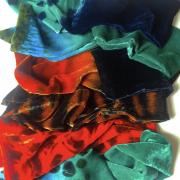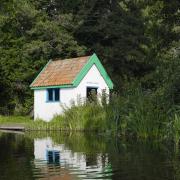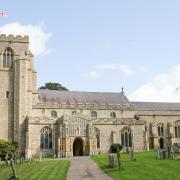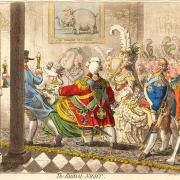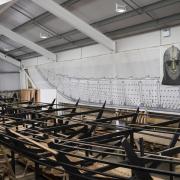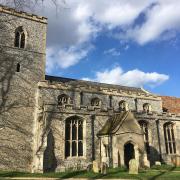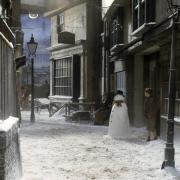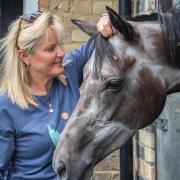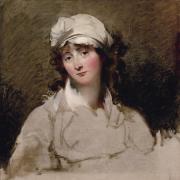They had walked past the building every day for years, but had thought nothing more of it. A distinctive, imposing presence on the village high street, once the headquarters of an early 20th century friendly society, it had been empty for some time. Its various uses as an antiques emporium, bathroom shop and even a filming location were no longer viable.
Local people told stories of how important the Foresters Hall had been in their lives. ‘Then one day the penny dropped,' says Susan Owens. 'My husband came home and said why don’t we buy it and make it our home?'
Susan and her husband, Stephen Calloway, are both art historians and former Victoria and Albert Museum curators. They moved to a beautiful medieval house in Debenham 10 years ago, but always wanted somewhere they could display their pictures, tapestries and artefacts to their full potential.

‘We’ve always collected things and this is exactly what we’d wanted. The high ceilings, the big windows, the space. We thought we could make something wonderful, and also save a building that was becoming derelict and couldn’t really be used for anything else.’
The Grade II listed property, originally owned by the Ancient Order of Foresters, was used as a meeting hall from 1905. It was closed in the 1960s, converted into showrooms and offices, and featured as Gimberts auction house in the BBC TV series Lovejoy. Upstairs was a large two-bedroom flat, from where the view over Debenham convinced Susan that this should be their home, even though it needed a lot of work after many years of abandonment.
Dirty brown carpets were stripped out and walls built to create smaller rooms within the vast space. The hall would originally have been a ballroom for dances, talks and gatherings with balconies around the perimeter; now a floor has been added so that downstairs Susan and Stephen work in two studies and a library, while upstairs is a large sitting and dining space.

‘We don’t know the details of what happened here,’ says Susan. ‘Were the talks meant as entertainment or were they educational, instructive? Almost everyone locally has a story about some event held here. A lot of people say they only exist because their parents or grandparents met at a dance here!’
Susan hopes to learn more about the property as time goes by, through research and talking to local people. But for now she’s busy with her ongoing projects, writing about history, art, literature and landscape, all made possible when she left her role at the V&A a decade ago.
‘We’d been on holiday and visited Kelmscott, William Morris’s house in Gloucestershire. We thought why don’t we live in a wonderful house? So my husband Googled medieval houses for sale and one in Debenham popped up.’

Susan grew up in Derbyshire where, she says, the earliest buildings she was used to were from the 17th century. ‘That was such an industrial place. It was a revelation to come to Suffolk and find that medieval houses and cottages were so plentiful, and people live in them without thinking they’re particularly unusual.’
Moving to Suffolk was the prompt she needed to channel her creative ideas into her own projects. She studied English at Oxford but gained a love of art through seeing works which weren’t on public display, in the print room at the Ashmolean Museum, and speaking to the curators.
After pursuing qualifications in art history, she became a curator of prints and drawings at the Royal Collection, based at Windsor Castle, shortly after the Queen Mother died. Susan's task was to select works which could be displayed in a public exhibition at the Queen’s Gallery, and also pictures to hang at Clarence House.

‘The Queen Mother had really interesting relationships with artists and I was able to read these wonderful letters written to her by people like John Piper and Augustus John, and Kenneth Clark, who was the Surveyor of the King’s Pictures during the war. I found her so fascinating. This figure I didn't even imagine existed, suddenly sprang out of all of this research.’
Despite the joy of working at Windsor, Susan was tempted away with a post at the V&A in London. ‘Their collection of paintings and watercolours and drawings is immense and there was such a lot of work to be done. It was like being let loose in a sweet shop.’ Her department was responsible for everything ‘from altarpieces to portrait miniatures, to medieval manuscript illuminations to contemporary drawings’. She needed a specialism, so she focused on drawings.
‘I love drawings because they are so direct,’ she says. ‘It’s almost like having a face-to-face encounter with that artist. You can see the trace of their hand on that piece of paper. You can see where they’ve hesitated, where they’ve made mistakes. There’s something incredibly alive and vivid about it for me.’ She worked there for seven years before the lure of living and writing in Suffolk took over. Her first book, about how ghosts have been perceived through history, was inspired by their house, she says.

‘An old house was assumed to be haunted,’ she says. ‘As we were buying our house in Debenham, it was amazing how many people talked to me about ghosts.’ That book was followed by Spirit of Place: Artists, Writers and the British Landscape, and in 2023 Imagining England’s Past looked at the country’s invented histories from the eighth century to the present day. All three books take an extraordinary sweep through history.
‘I love taking the long view because I think that you can spot patterns and make connections. And it can be quite an exhilarating way of telling a story.’ Why do we all have such a fascination with the past? ‘I think there’s a sense of safety – it’s done and there’s a kind of comfort in that,' she says.

'But also I think there’s an enchantment which perhaps we don’t find in the present day. By visiting ruins or National Trust houses we fill in what we imagine might have taken place. As we look back, we tell stories to make sense of it. In a way, the past doesn’t exist except in our minds and how we interpret the objects and the memories.’
This fascination throughout generations has inspired art, literature, music, architecture and fashion. ‘The Victorians were completely in love with the past. I think because at the time, everything was moving so quickly.’ So, says Susan, they looked to the Middle Ages for their inspiration, to the Gothic.
‘The same thing happened in the interwar period with a lot of artists becoming absolutely obsessed with the idea of pre-history. Artists like Paul Nash, John Piper, Barbara Hepworth, they all looked at standing stones, stone circles, Neolithic barrows, and they made art from them. These ancient sites seemed to give some kind of stability, some sense of nationhood, some sense of deeply shared paths that were so rooted in the landscape and in history that they were unshaken by whatever horror was happening.’
Even Susan’s and Stephen's Debenham home looks backwards as well as forwards. Before the welfare state came into being, the Ancient Order of Foresters sought to help local people build lives for the future, but the building is Palladian style, inspired by the designs of a 16th century architect who, in turn, drew on ancient Roman and Greek buildings. It will be interesting to see how Susan and Stephen seek to honour the past, present and future of their new old home.






